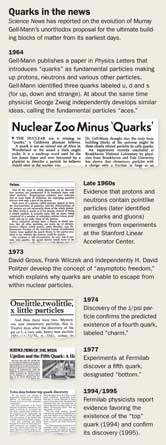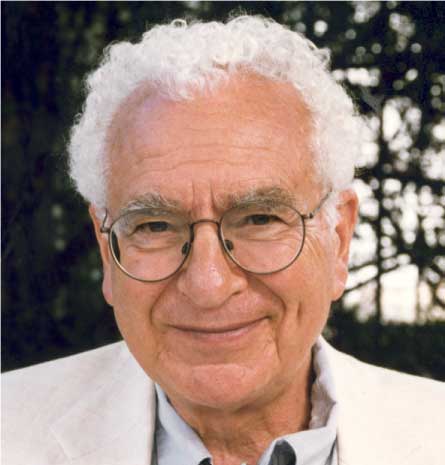- More than 2 years ago
When in the course of scientific events it becomes necessary to dissolve allegiances to established beliefs, you can expect to face a lot of flak.
New scientific ideas, the German physicist Max Planck once observed, triumph not because of the power of reason, but because their opponents eventually die. It was perhaps a slight exaggeration. But it certainly reflects the spirit of scientific conservatism infused in the textbooks, journals and academic departments that impose disciplinary consensus on students and their teachers. Science’s methods are so powerful, its defenders sometimes contend, that views contrary to current consensus are too likely to be wrong to be taken seriously.
Nobody understands this pressure from the scientific establishment better than Murray Gell-Mann, the Nobel laureate physicist who identified quarks as the ultimate building blocks of most earthly matter. Gell-Mann, who turns 80 on September 15, has witnessed resistance to many groundbreaking advances during his long career, including some of his own.
“Most challenges to scientific orthodoxy are wrong,” he emphasizes. “A lot of them are crank. But it happens from time to time that a challenge to scientific orthodoxy is actually right. And the people who make that challenge face a terrible situation.”
Take quarks, proposed by Gell-Mann in 1963 as the constituents of protons, neutrons and certain other subatomic particles. “A lot of people thought the quarks were a crank idea,” Gell-Mann said in an interview last month during a visit to the Institute for Advanced Study in Princeton, N.J.
As it turned out, though, quarks signified one of the deepest insights into the nature of matter since the prescient reflections of the ancient Greek atomists. Many scientists have tried, but so far none have succeeded in digging more deeply in seeking matter’s ultimate constituents. One recent paper, for instance, proposes that quarks and electrons alike are composed of more basic entities named “spinons.” Older suggestions invoked “preons.” So far neither their names nor the evidence for them matches that of quarks. More than four decades after Gell-Mann conceived them, quarks retain their standing as the indivisible building blocks of every known tangible substance.
Sure, electrons buzz about and orchestrate the curiosities of chemistry, but quarks are responsible for more than 99.9 percent of ordinary matter. No example provides better reason to beware of blind dismissals of novel ideas. And no story better illustrates the power of science to deduce aspects of reality deeply hidden from human senses.


Atomic deconstruction
In the ancient days of science’s infancy, great thinkers pondered deep questions about matter — such as how finely it could be sliced and diced. One group of Greeks proclaimed that matter could be cut only so much before reaching a limit they labeled with the alluring term atomos — uncuttable.
Millennia later, chemists and physicists built their sciences upon the foundation provided by the idea of “atom.” But the triumph of atomism unveiled a confusion. As it developed, the Greek notion of “atom” contained two different concepts. On the one hand, it meant the smallest unit of a substance. On the other, it was supposed to mean unsplittable. But those turned out not to be the same thing. Atoms are indeed the smallest units of the chemical elements, but can (very dramatically) be split.
A century ago, physicists had realized that atoms have parts and were on the verge of figuring out atomic architecture. Ernest Rutherford’s assistants had witnessed alpha particles bouncing off a thin sheet of gold foil — as astounding, Rutherford later said, as tissue paper repelling artillery fire. He soon figured out that the alpha particles had encountered atomic nuclei, the specks in the center of every atom occupying almost none of the space but concentrating almost all of the mass. Scientists spent the next half century tearing the nucleus apart in search of matter’s ultimate constituents.
By the 1950s, those efforts had produced perplexity. Atomic nuclei contained two types of particles, or nucleons: the proton and the neutron. Observations of cosmic rays and experiments with atom smashers, though, disclosed numerous other seemingly basic particles, with weird names like pion, lambda, delta and sigma, threatening to exhaust the Greek alphabet. Enrico Fermi famously muttered that he might as well have been a botanist if he had to remember so many odd names.
Amidst that chaos, Gell-Mann saw a pattern. In 1961 he (and independently, Yuval Ne’eman) perceived an analogy between some arcane mathematics and the properties of the known particles. Gell-Mann sorted the particles into tables, reminiscent of the periodic table of the chemical elements devised by the Russian chemist Dmitri Mendeleev almost a century earlier.
Just as Mendeleev had predicted the existence of previously unknown elements based on gaps in his chart, Gell-Mann forecast the discovery of new particles. As certain classes of particles came in groups of eight, he called his system “the eightfold way,” although subsequent comparisons to Eastern mysticism annoyed him. “I meant it as a joke,” he once proclaimed.
Mendeleev’s periodic table accomplished much more than predicting new elements. It also served as an early warning sign that atoms were not indivisible. His table showed that when listed in order by weight, atoms displayed patterns in their properties: columns in the table contained families of similar elements. Such a repetitive pattern of properties suggested that atoms within a column possessed arrangements similar to others in their family —implying that there were some internal parts to arrange. In much the same way, the regularities in Gell-Mann’s tables implied deeper structure in nature’s basic particles.
At the time, many physicists believed that the proton, neutron and cousin particles might all be equal partners in a conspiracy to create themselves. In other words, no one particle was truly basic — each was a combination of some of the others (perhaps even including itself). This “bootstrap” principle avoided the need to declare any one particle the ultimate chip off the atomic block.
Gell-Mann, though, found what he described in a 1964 paper introducing quarks as a “simpler and more elegant scheme.” All the relatives of protons and neutrons in the subatomic zoo, including the proton and neutron themselves, could be explained as composites made from three basic building blocks. Each had its own label: u, d and s, for up, down and strange. He chose the name quark (the squawk of a gull) from a line in James Joyce’s Finnegans Wake: “Three quarks for Muster Mark.” (Independently, the physicist George Zweig suggested a similar idea, calling the building-block particles “aces.” Not quite as catchy a name.)
Quarks challenged orthodox physics on several levels, violating at least three prevailing principles. “One of them was that the neutron and proton were elementary — they were not composed of anything simpler,” Gell-Mann said during the Princeton interview. Second, quarks had to be permanently trapped inside observable particles, also defying beliefs held by many physicists. “That was a crazy idea, they thought,” he said.
Third, quarks possessed the awkward property of fractional electric charge, something never observed (even to this day) for a subatomic particle. All observable charged particles possess some integral multiple of the charge on an electron, the smallest unit of charge that nature offers. “The idea of particles with fractional charges — that was considered to be a crank idea too,” Gell-Mann said. “So the quarks had three strikes against them, from these three principles — all wrong, of course.”
Quarks proliferate
Over the years, support for the quark idea grew, though, even as Gell-Mann’s original elegant picture became somewhat more complicated. A new particle discovered in 1974 implied the existence of a fourth quark, called charm (a sort of partner for the strange quark, just as up partnered with down). Three years later evidence turned up for another quark. This one was called bottom, naturally requiring a sixth quark — the top — not definitively discovered until 1995.
Most experts today doubt there will be any more quarks. But nobody can say for sure that quarks themselves will forever reign as the ultimately unsplittable units of matter.
“So far nothing has pointed in that direction, of another layer of constituents underlying the quarks,” Gell-Mann says. “But you can’t rule it out completely, of course. We know that the present theory, the standard model, is a low-energy approximation of some kind to a future theory, and who knows what will happen with a future theory?”
Lack of evidence for quark parts doesn’t prevent people from investigating the possibility, though. One new scheme, for instance, describes particles that could combine to make not only quarks but also leptons — the electron and its relatives — and bosons, the particles that carry forces governing interactions between other particles.
In a recent paper describing this idea (arxiv.org/abs/0907.2538), Eckart Marsch of the Max Planck Institute for Solar System Research in Germany calls such all-purpose building blocks “spinons.” Using mathematical symmetry principles similar to those underlying quarks, he shows how spinons and their antimatter counterparts could combine to create particles resembling the known quarks, leptons and bosons.
Three spinons, for example — two of one kind, one of another — could make particles with electric charge of +2/3, like the up quark, or -1/3, like the down quark. Other combinations of three spinons would reproduce the properties of electrons and their cousins. Unions of two spinons could produce bosons such as the W particles responsible for transmission of the weak nuclear force. One combination of two spinons even reproduces properties expected of the hypothetical Higgs boson, about to be the subject of an intense search at the world’s newest atom smasher, the Large Hadron Collider at the CERN laboratory on the outskirts of Geneva (SN: 7/19/08, p. 16).
Past suggestions about composite quarks have failed when tested by experiment, and no one would be surprised if the spinon idea also fails to overturn the scientific consensus.
Language barriers
Gell-Mann, meanwhile, remains active in research at the Santa Fe Institute in New Mexico, where he continues to pursue ideas that are sometimes at odds with establishment views. He is particularly interested in linguistics, for instance, and collaborates with researchers at Santa Fe and in Moscow studying distant (in time) relationships among human languages.
“In that collaboration we seem to be finding more and more evidence … that a very large fraction of the world’s languages, although probably not all, are descended from one spoken quite recently … something like 15,000 to 20,000 years ago,” Gell-Mann says.
Language surely originated much earlier than that, he says, but most languages still around today may have descended from this mother of (nearly) all mother tongues, tentatively labeled Borean (as in “the north wind”).
Of course, many experts resist the idea.
“For some reason, in this country and in Western Europe, most tenured professors of historical and comparative linguistics hate the idea of distant relationships among human languages, or at least the idea that those can be demonstrated,” Gell-Mann says. “They put a tremendous burden of proof on anyone who wants to say that languages are related in this way, by this common descent.” And so once again Gell-Mann faces what he calls the “negative principles of the establishment.”
“Eventually I think everybody will be convinced that these relationships really exist,” he says. “In the meantime, we’re fighting one of these battles.” And just as there’s no evidence of constituents of quarks, there’s no evidence that Gell-Mann will stop fighting such battles anytime soon.







